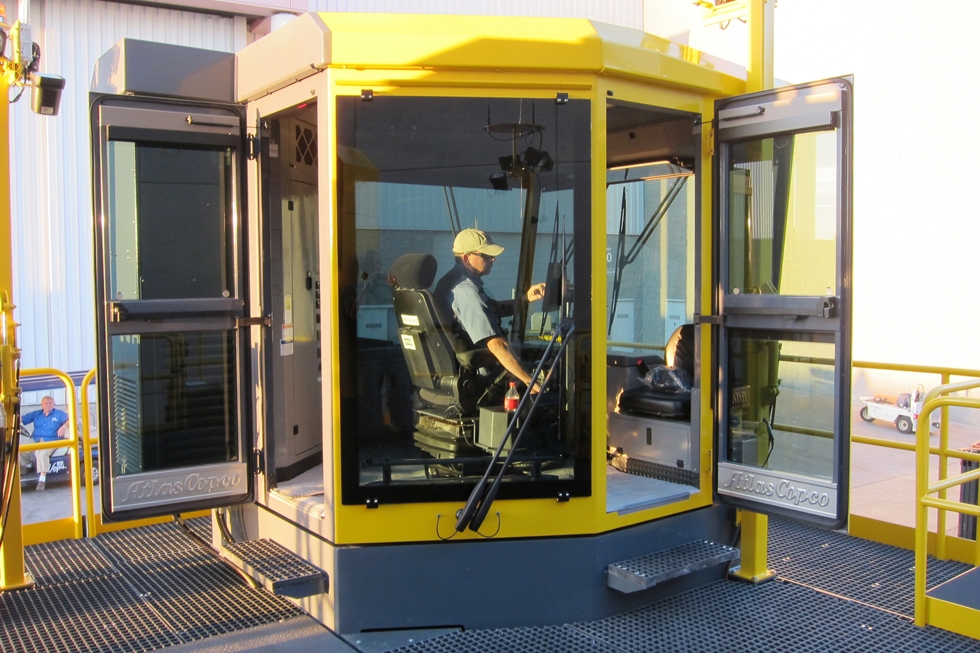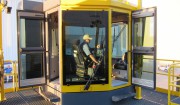A brand new drill rig takes the stage
Pit Viper 311 is the first in what will be a new series of single- and multi-pass rotary blasthole drill rigs from Atlas?Copco. Called the PV-310 Series, the new rigs will be based on the same successful concept as other Pit Viper models but will cover the 228?311 mm (9?12?¼ in) hole range, thereby filling the gap between the PV-271 and PV-351 series.
The first rig, the PV-311, is typical of the new range ? lighter in weight, more fuel efficient, comfortable, easy to use and service friendly. So what was the driving force behind the development of the rig and what are the main advantages for future owners?
The customer?s needs
The process of designing any new drill rig at Atlas Copco always starts with the customers? needs, in this case the need to increase the efficiency of single-pass drilling in the 311 mm hole range with a 110?000 bit load.
The PV-311 offers bit changing above the deck combined with a single-pass depth capacity of 19.8 m (65 ft), or a maximum of 41 m (135 ft) with two additional 35 foot rods in the standard carousel.
The new rig also offers many of the upgrades originally developed for the PV-235 coupled with the successful design elements of the PV-351, including the drilling angle option of 0?20 degrees in 5 degree increments.
Customers who are familiar with, or own a PV-351, will recognize these design strengths and appreciate the commonality of parts, and mines already using the PV-351 will see the advantage of adding the new PV-311 to their fleets.
Iain Peebles, Atlas Copco Project Manager, explains: ?Our design team focused on maintainability and high productivity for this newest addition to the Pit Viper Series and our design plan targeted lifespan savings for the customer.
?We utilized many proven systems from our other Pit Vipers but made minor improvements to maximize the productivity and reliability of the PV-311 to save customers money in everything from fuel to extra maintenance. ?
Peebles continues: ?We?ve come a long way since the Pit Viper series was introduced 12 years ago. Today, design technology and tooling has given us a big advantage. The computer modeling used today just wasn?t available 15 years ago when my predecessors were first designing the Pit Viper series. We utilized computer drafting, finite element analysis, and structural calculation tools to optimize the tower structure, minimizing the weight while maximizing the expected lifespan.?
Savings in the tower
The tower is a key component for a -rotary blasthole rig and Dustin Penn, -Atlas -Copco?s Blasthole Drills Product Line Manager, says the new PV-311 tower will benefit maintenance. ?As we have a deeper tower, we have been able to further improve our patented cable feed system. In addition to our auto-tensioning feature we are also -using large diameter sheaves with sealed bearings. All that adds up to increased -cable and sheave life, plus that this system requires less maintenance.?
The upgraded and well proven two-speed rotary head, already used for the DM-M3, provides drill rotation. Penn adds that the new rotary head now operates with larger motors that offer better lubrication for increased spline and main bearing life. Futhermore, the previous head offered just 13.8 kNm (10?183 lb-ft) of torque whereas the new head offers a substantial increase to 17.5 kNm (12?900 lb ft) of torque at low speed (140 rpm) and 10.2 kNm (7?500 lb ft) of torque at high speed (240 rpm).
Service work around the new tower will be easier, too. Technicians will have the benefit of an access hatch that fully encloses the fiber-grate catwalk along the length of the tower. In addition, a Tower Access Restraint system enables them to secure their harnesses to a cable shuttle so that they are able to move throughout the tower area leaving both hands free to carry out their work.
More options
The PV-310 series offers several options in its single- and multi-pass versions, starting with the engine. To match the customer?s brand preferences and to meet regulatory demands, the Tier 4 engines are available with the Cat C32 and MTU 16V2000 and Tier 2 options can be provided with diesel engines from Cat, MTU or Cummins. A power pack with electric engine will also be available in the future.
Air compressors are also optional in both Atlas Copco and Ingersoll Rand models. At the outset, Atlas Copco Twin S3 and Ingersoll Rand 2 x 285?mm airends will be available, both capable of delivering 1?400 l/s at 7.5 bar (3?000 cfm at 110 psi).
An optional feature first developed for the PV-235 ? the automatic hydraulic clutch ? is also available on the new PV-311. The system allows the operator to turn off the compressor with the push of a button when not in use. To engage the clutch, the operator hits a button on the chair?s control panel.
Peebles says: ?We found that in some cases over 50 percent of the time the engine is running, the rig is not drilling and the compressor is not needed. By disengaging the compressor during leveling, tramming, changing drill pipe, or idling, the engine uses less fuel. Component life can also be extended by changing the service intervals to actual hours on the compressor.? (For more information see M&C 2, 2012, Technically Speaking).
RCS as standard
One high-tech feature that is not optional on the PV-311 is the Rig Control System (RCS) which is Atlas Copco?s proven CAN-bus electronic control system. RCS Basic is standard and there are optional packages available including AutoLevel, AutoDrill, GPS hole navigation and teleremote control.
Low technology features also contribute to productivity. The standard diesel fuel tank has a capacity of 2?650 liters (700 US gallons) and provides sufficient fuel for 12 hours of operation. Optional fuel/water tank alternatives are available providing sufficient fuel for the rig to operate for a full 24 hours before it has to stop for refilling.
Control and comfort
No other design feature distinguishes the new PV-311 from other drills in the Pit -Viper family more than its cab. It is the result of a year-and-a-half of engineering that incorporates utility and comfort with high-tech control. From the center of the cab, which is fitted with a wall-to-wall, heavy duty -removable mat and shaded windows, the operator?s seat offers a full view of the platform and work area.
Advanced features include infrared touchscreens that feed drilling data to the operator while additional safety monitors show movement from a ground surveillance system, and video feeds from closed-circuit television cameras.
Operators will especially enjoy the convenience of an optional refrigerator and microwave while they hum along to their favorite music fed through the USB connection. And they will also stay cool even in the world?s hottest mines thanks to the 12 kW air conditioning system which includes a hydraulic compressor and a condenser fan that reduces overall machine electrical requirements.
Control and comfort
The cab?s central electronics cabinet offers many benefits for the maintenance technician. Service access doors open from floor to ceiling giving full access to all electronics. The well-lit cabinet allows open spaces for technicians to maintain the existing equipment and can add new modules and functionality as needed.
Penn concludes that the PV-311 is ideally suited for the copper and coal mines of Chile, Peru, Southwest U.S., Russia and Western Canada as well as the metals mines of Africa and Indonesia. And he predicts that the 90 m (295?ft) multi-pass PV-316 model will be the perfect match for the Powder River Basin in the U.S., Eastern Australia and the coal mines of South Africa, China and India.
A world first in underground mining
Minetruck MT85 is the largest articulated underground mining truck in the world. Planned for launch in 2014, it is designed for demanding conditions and maximum productivity with a high focus on safety, ergonomy and operator comfort.
Ben Thompson, Atlas Copco Product Manager, says: ?This truck is designed to fit the same drift dimensions of 50 and 60 tonne class trucks with one essential difference. It will haul 85 tonnes which gives a tremendous productivity boost in terms of fewer trucks and tonnes/kilometers per hour.?
Thompson emphasizes that the Minetruck MT85 truck is also fast and highly maneuverable on ramps and inclines. ?This means that fewer cycles need to be made which, in turn, reduces the cost of transport in relation to the amount of material hauled.?
Not only that, the Minetruck MT85 truck now gives mining companies a more cost effective way to haul ore in the mine and make it more attractive to go for deeper ore bodies via a ramp instead of sinking a shaft.
High capacity compact
The Minetruck MT85 has a high capacity but fits a small ?envelope?. It is 3.4 m wide and 3.5 m high, easily fitting into drifts of 6.0 x 6.0 m. And despite its length (14 m), it has an impressive turning radius of 44 degrees, which is largely thanks to its electro-hydraulic steering of the rear axle which gives maximum maneuverability.
Modularity and options
The Minetruck MT85 truck also offers a high degree of modularity and options. The dump box can be tipped at the side of the vehicle as well as at the rear. There are also two tailgate configurations (hinged either at the top or at the bottom), three engine alternatives (535, 760 or 1?010 hp) as well as four-wheel or six-wheel drive to fullfil differen-t customer?s needs or mine requirements.
Epiroc operated under the trademark “Atlas Copco” prior to January 1, 2018.



Here:
Us: